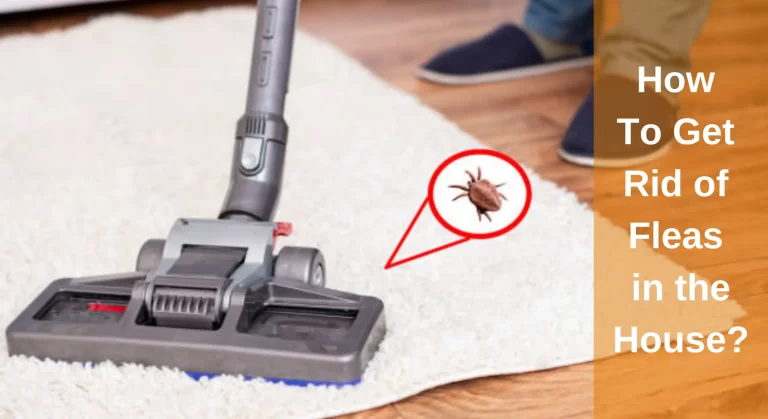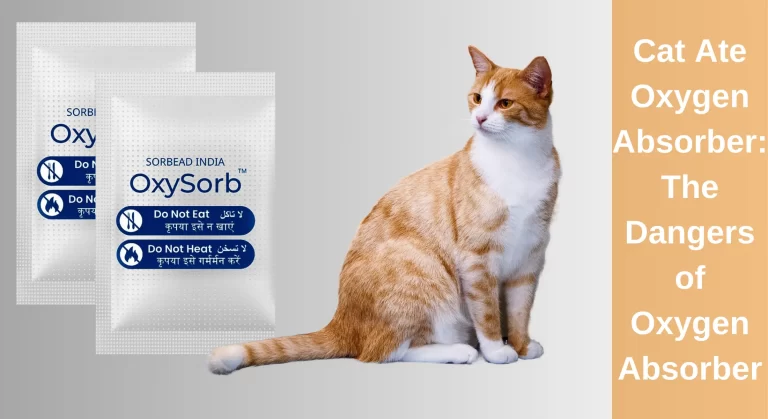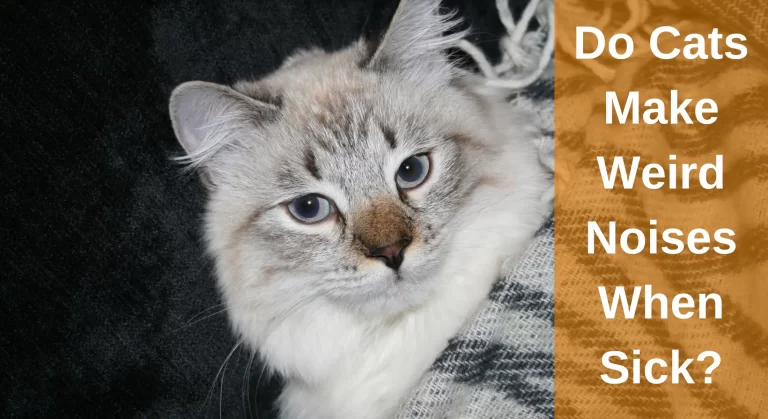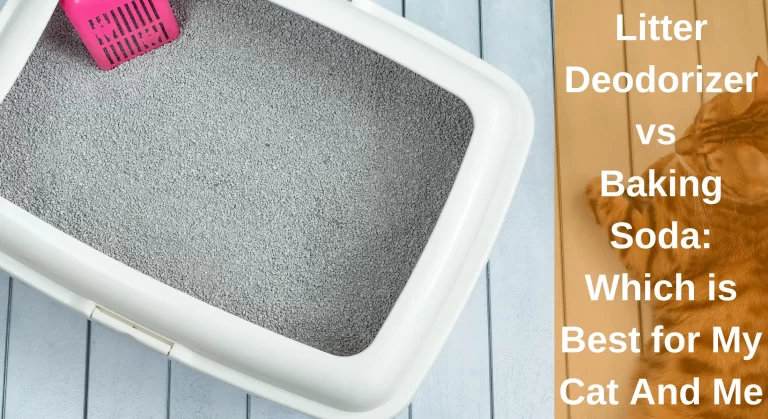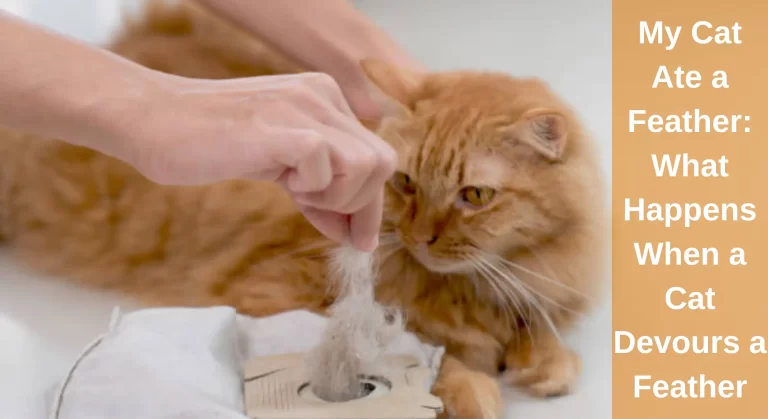My Cat Ate Insulation: What To Do Now [Answered]
Cats are adorable, yet their innate curiosity frequently leads to trouble. This is particularly true while they are playing because they become overexcited and eat anything they really shouldn’t have. So, if you have insulation in your house, terrible incidents may occur if a curious cat gains access to it and eat it. You may become worried and ask does your cat will be all right if your cat ate insulation.
If your cat has ingested insulation, it is important to seek immediate veterinary attention. consuming insulation can clog your cat’s stomach, and cause severe damage including gastrointestinal blockages, respiratory issues exposure to toxic substances. Also, it may spread all around your cat’s fur and create fiberglass allergies. In order to prevent any of these horrible situations, it is advisable to bring your cat to the veterinarian ASAP.
You adore your cats and are willing to go to great lengths to care for them. As a result, you need to be alert to any dangers your home’s insulation may cause to your cat. In this article, we will explore the dangers associated with cats consuming fiberglass insulation, the potential symptoms to watch out for, and the necessary steps to take if your feline friend encounters this predicament.
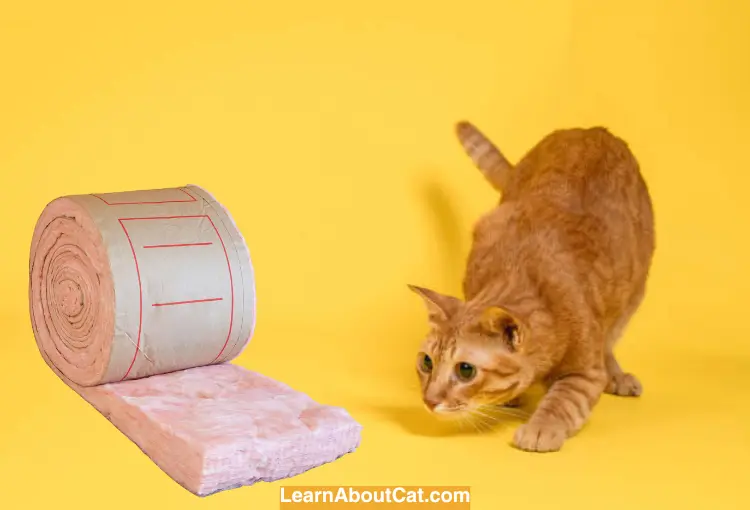
What Should I Do if My Cat Ate Insulation?
If your cat quickly nibbled on some fiberglass, a hot bath with a light detergent is a good starting point. If your cat managed to get any fiberglass particles on their fur, you can wipe them with hot water and cider vinegar diluted 50/50.
Contact Your Vet Right Away or just take your cat in there if she takes a sizable piece of it or you’re just not sure. Although she may look fine, the fiberglass can certainly cause intestinal discomfort. If the fiberglass has entered into their epidermis, your veterinarian can prescribe medications that are considerably more effective than those available at pet stores.
Moreover, to determine whether your cat does have an obstruction, the vet may request X-rays. If so, an operation might be needed to free the obstruction and fix any harm the insulation may have done. According to how serious her illness is, your furry pet may have to spend some time at a medical facility.
Treatments are based on the location of the blockage. The vet might be able to get rid of the insulation in some circumstances by performing an endoscopy operation. The vet might have to operate to eliminate the insulation if it is located deep in the cat’s gastrointestinal tract.
The outcome is greatest for cats who seek medical attention right away after consuming insulation.
Check Out: My Cat Ate A Quarter: What to Do Now [Answered]
Symptoms of Insulation Ingestion in Cats
You’re fortunate if you capture your cat chewing insulation. Sometimes cat owners don’t even realize their insulation has been consumed unless their cat starts to show signs. Cats may get the following negative effects from consuming fiberglass insulations:
- Irritation and Pawing at the Mouth
- Yellow gums
- Salivating
- Alterations in pulse rate
- Having trouble urinating
- Instability while walking
- Respiratory issues
- Blisters
- Renal failure
- Dysentery
- Convulsions
- Nausea
- Bleeding nose
- Tremors
- Aggression
- Constipation
- Bleeding in feces
Also Check Out: My Cat Ate a Dryer Sheet: What to Do Now [Answered]
What Happens if You Swallow Fiberglass Insulation? Can Insulation Kill a Cat?
It might be fatal for your cat to ingest fiberglass insulation, in rare cases, be life-threatening, which is why we advise you to seek immediate medical attention if you think your cat has done so. The dangers that your cat runs without emergency services are listed below.

Clogging
The fiberglass insulation isn’t edible even if it may not be harmful. While attempting to push the fiberglass insulation down their esophagus, they risk choking. If they accidentally ingest it, it may result in obstructions after it enters their intestinal tract. If there is a blockage, organ damage may result, and the blockage of fiberglass in your cats’ intestines may also hinder their blood circulation. Even if your cat succeeds to pass the fiberglass in the feces, still, this can be challenging.
Internal Injury
The aforementioned obstructions are still possible, but your cat is additionally in danger of intestinal harm. The insulation’s abrasive exterior can irritate a cat’s gut and gastrointestinal lining as well as scrape the esophagus while passing through the mouth.
Internal injuries could, at their worst, happen. Your cat may have breathing problems, an enlarged stomach, yellow gums, and the potential to die because of their wounds’ severity. Internal hemorrhaging must be handled as a medical crisis that necessitates a rapid appointment with the veterinarian.
Poisoning
Your cat shouldn’t be permitted to consume insulation because it may pose a risk of poisoning. The reason for poisoning is that fiberglass insulation is covered with formaldehyde chemical which is lethal for cats.
Fidn Out: Cat Ate Oxygen Absorber: The Dangers of Iron Oxygen Absorbers for Cats
Why are Cats Attracted to Insulation?
Here are a few potential causes for why cats are drawn to insulation:

- Texture: Fiberglass insulation has a smooth, airy texture that attracts cats. Insulation may provide sensual pleasure for cats because they are recognized to like rubbing and chewing soft objects.
- Chewing and Biting Habits: Cats have a natural instinct to chew and bite objects, especially when they are teething or bored. Insulation, with its soft and pliable nature, can become a target for their chewing instincts.
- Warmth: Because the insulation is intended to keep houses warm, felines may find solace in its warmth. Cats are notorious for looking for warm places to cuddle up, and insulation may offer them a comfortable setting.
- Hiding places: Attics, cellars, or other isolated parts of a house are frequently lined with insulation, which makes them appealing to cats as safe havens. Cats are naturally inquisitive and want to discover new locations, and they may be attracted to insulation’s confinement.
It’s important to remember that certain insulation substances might be poisonous or induce breathing issues in cats if they swallow or ingest them. It’s crucial to call a vet straight away when you own a cat and they have eaten insulation.
Also Read: My Cat Ate a Feather: What Happens When a Cat Devours a Feather
Types of Insulation Cats May Ingest
Cats can potentially ingest different types of insulation materials found in homes or other buildings. It is important to be aware of these materials to understand the potential risks involved. Here are some common types:
- Fiberglass Insulation: This type of insulation is made of tiny glass fibers. If ingested, it can cause irritation and damage to a cat’s digestive system.
- Foam Insulation: Foam insulation comes in various forms, such as polystyrene and polyurethane foam. Ingesting foam insulation can lead to intestinal blockages or other gastrointestinal issues.
- Mineral Wool Insulation: Made from spun fibers of minerals like rock or slag, mineral wool insulation can cause similar issues as fiberglass if consumed by a cat.
Also Find Out: My Cat Ate a Feather: What Happens When a Cat Devours a Feather
Can Cats Get Sick From Eating Insulation?
Yes, cats can get sick from eating insulation. Insulation materials, such as fiberglass, can cause irritation and damage to the mouth, throat, and digestive tract.
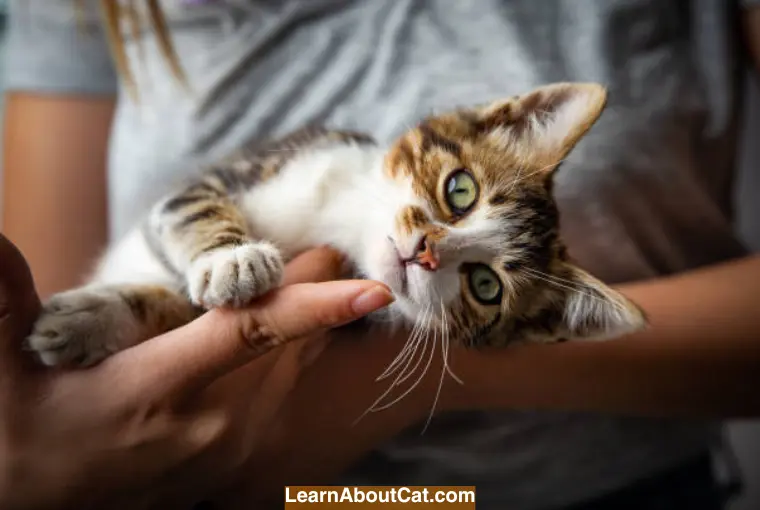
Even though the fiberglass fibers themselves are not dangerous, they have been formaldehyde-treated, which makes cats sick. There is also the issue of the dust and dirt they carry, which scratch cats. For example, breathing in these particulates might lead to ulcers in your cat’s mouth or nostrils.
Besides getting hurt, your cat would probably be scratching against items aggressively in an attempt to itch. Moreover, the whole GI tract may become irritated by fiberglass’s abrasive texture. They may also strive to lick the fiberglass from their furs, which raises the risk of tongue and windpipe ulcers as well as fibers entering into their lungs.
Additionally, some types of insulation may contain toxic substances or chemicals that can be harmful when ingested by cats, leading to poisoning or other adverse effects. As a result, your cat will probably throw up, and it might even get some diarrhea along with that. Nevertheless, situations could become worse, so it’s important to call your veterinarian immediately for advice on what to do next.
How to Keep Cats Away from Insulation
To keep pets away from insulation, you can take the following measures:
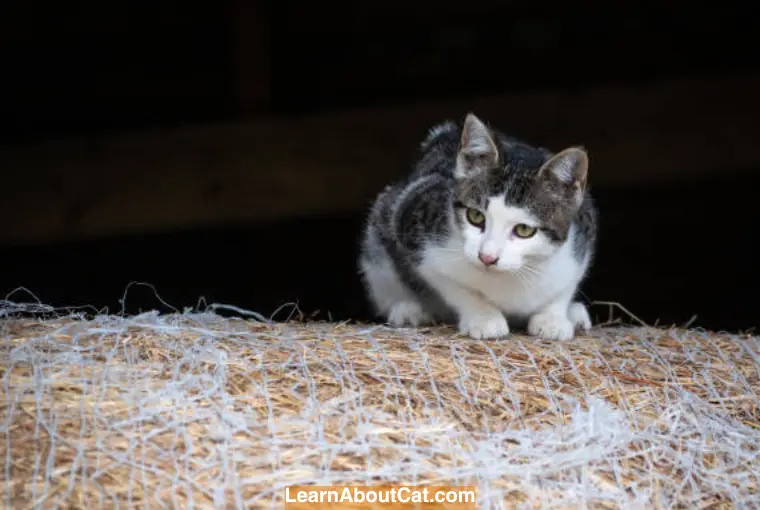
- Limit Access: Block off areas where insulation is present, such as crawl spaces or exposed insulation in attics, by using physical barriers like doors or gates.
- Provide Alternative Spaces: Create a designated and comfortable space for your pets with their own bedding, toys, and scratching posts to divert their attention.
- Use Deterrents: Apply pet-friendly deterrent sprays to the areas where you want to keep your pets away. These sprays have scents that pets find unpleasant and can help discourage them from approaching the insulation.
- Provide Mental Stimulation: Engage your pets in interactive play, provide puzzle toys, or establish a regular exercise routine to keep them mentally and physically stimulated.
- Training and Positive Reinforcement: Train your pets using positive reinforcement techniques to reinforce boundaries and discourage them from exploring prohibited areas.
- Use Pet-Proofing Products: Consider using pet-proofing devices such as pet gates, indoor fences, or door protectors to prevent access to insulation.
- Supervision: Keep a watchful eye on your pets, especially when they are in areas where insulation is present, and redirect their attention if necessary.
Safe Alternatives for Cats to Chew On
To satisfy your cat’s natural chewing instincts, provide safe alternatives to insulation. Some suitable options include:
- Cat-safe chew toys: Offer a variety of cat-safe chew toys made from materials specifically designed for feline chewing needs.
- Interactive feeding toys: Use interactive feeding toys that encourage mental stimulation and physical activity, keeping your cat engaged.
- Cat grass or catnip: Consider growing cat grass or offering catnip as an alternative outlet for chewing behavior.
Intresting Reading: My Cat Ate Rubber Band? What Should I Do
Frequently Asked Questions
Will fiberglass insulation hurt a cat?
Yes, cats could be harmed by fiberglass insulation if they eat it or breathe it in. The small glass fibers that form fiberglass are readily broken off and propelled into the atmosphere, where they can irritate and harm the eyeballs, epidermis, and breathing system. Fiberglass insulation may harm a cat’s gastrointestinal system and result in obstructions in the intestines or other medical conditions. Chronic cough, sniffing, red eyes, itchy skin, nausea, and diarrhea are some signs of fiberglass toxicity in cats.
Is foam insulation toxic to cats?
Like a variety of construction materials, urethane foam insulating material can be hazardous to cats if swallowed or breathe in excessive quantities. This kind of insulation includes isocyanates that may irritate the skin, and induce breathing issues in cats as well as other health issues. Cats who have been exposed to isocyanates may exhibit symptoms such as asthma, congestion, breathing problems, nausea, diarrhea, and itchy skin.
How long does it take for symptoms to appear if a cat eats fiberglass insulation?
The timeframe for symptoms to appear if a cat eats fiberglass insulation can vary. In some cases, symptoms may arise within a few hours to a couple of days after ingestion. However, it’s important to note that not all cats will exhibit immediate symptoms. It largely depends on the amount ingested, the individual cat’s tolerance, and the presence of any underlying health conditions
Final Words
Your cat may experience several difficulties if it consumes insulation. Cats can become seriously ill from ingesting fiberglass insulation because it frequently obstructs their digestive tracts, resulting in symptoms including vomiting, diarrhea, and stomach pain.
Although your cat seems fine, it will be preferable to take it to the nearest clinic because of fiberglass dermatitis and the potential for fiberglass dust inhalation.
Your cat will be okay if you get them immediately to the veterinarian, however, in the meanwhile, do everything you can to keep them nourished.
Related Posts:
- My Cat Ate a Whole Bag of Treats: What Should I Do? [Answered]
- My Cat Ate Plastic Wrapper: What Should I Do
- My Cat Ate My Garlic Bread: What Should I Do [Answered]?
- My Cat Ate Chocolate Muffin Wrapper:
- Can Cats Eat Gum? A Look at the Risks and Dangers
- Can Cats Eat String Cheese?
- Why Do Cats Like Hair Ties? [Explained]
Who is Isabella?
My name is Isabella, and I am a dedicated and knowledgeable cat enthusiast. With years of experience caring for cats and a deep love for felines, I made a mission to help other cat lovers navigate the challenges of cat ownership.

